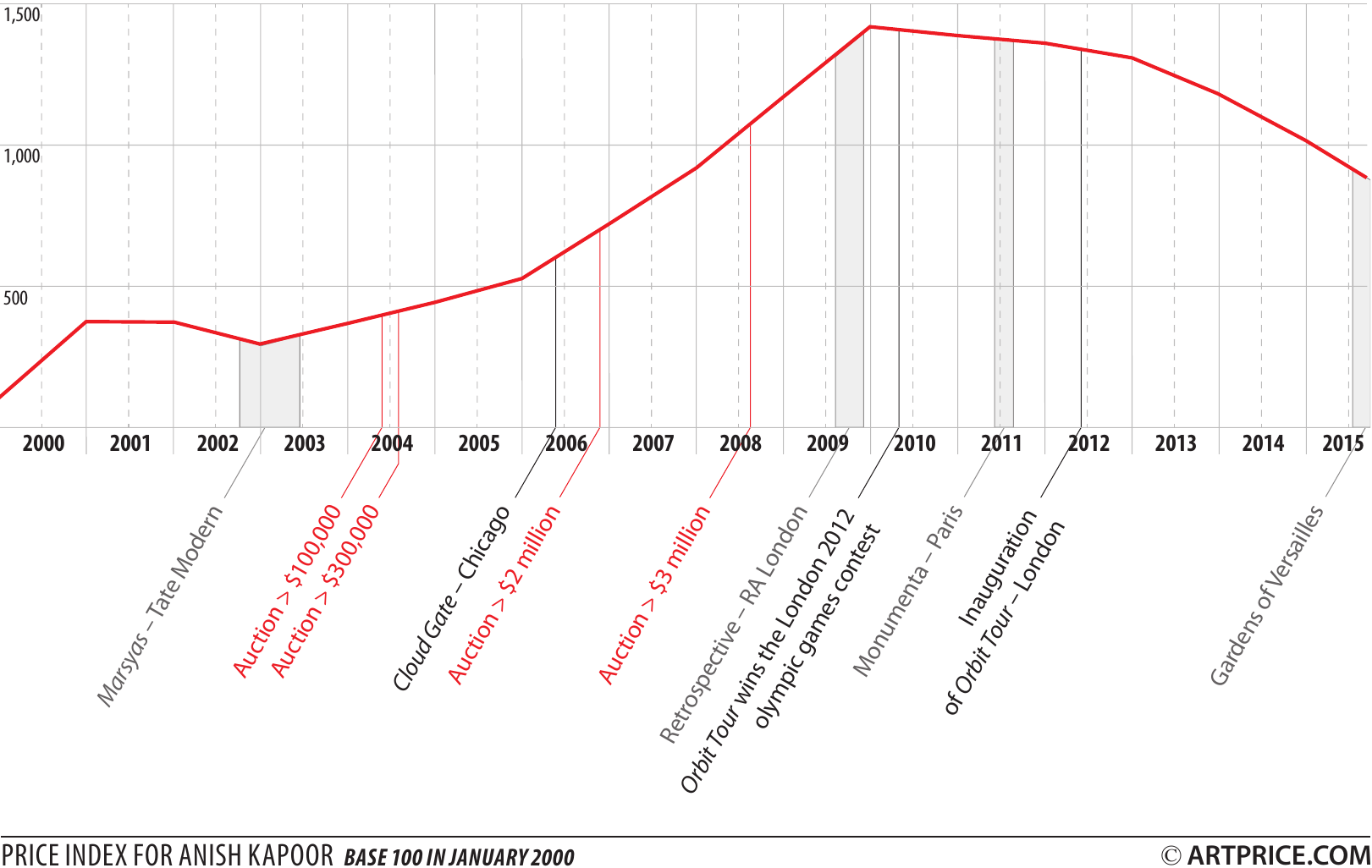Anish KAPOOR – monumental
A British citizen of Indian origin, an internationally recognised and collected sculptor, Anish KAPOOR has acquired a sensational CV. Invited by all the major museums and supported by powerful galleries, he represented the United Kingdom at the 1990 Venice Biennial with The Healing of St. Thomas, his first work to integrate architecture in such a bold manner. Since then, he has been regularly rewarded with honours and prizes: the Turner Prize in 1991, Member of the Royal Academy since 1999, appointed CBE since 2003, and ‘king’ of the Gardens of Versailles this year.
Anish KAPOOR has become a favourite for collec-tors and major museums alike. His success has al-lowed him to elaborate gigantic works and create sensory experiences that are as disconcerting as the technical prowess that contributed to their creation.
After his first bright colour pigment installations that brought him fame at the beginning of the 1980s, his creations become increasingly audience-immersing and monumental. Today, Anish KAPOOR uses state-of-the-art technologies in projects that mobilise between twenty and eighty people and sometime need several hundred tons of steel, or PVC or wax. Indeed, the search for immateriality at the heart of his work paradoxically requires vast quantities of materials. Remember that Kapoor considers his ladders as his primary sculpting tools and that he gladly accepts invitations to inhabit grand open spaces (like the Versailles Gardens) for which he can design works without dimensional constraints.
His first monumental project dates back to 1999 when the Baltic Center in Gateshead commissioned Taratantara. Three years later he installedMarsyas, a 4,000 square metre majestic artery in PVC membrane, at London’s Tate Modern, probably the best use ever made by an artist of its immense Turbine Hall.
However in 2011, at the Paris Monumenta exhibition, Kapoor designed an even grander project for the city’s enormous Grand Palais: Leviathan was a monochrome PVC structure weighing 15 tons and measuring 35 metres high, 72 metres long and 33 metres wide. Kapoor’s daring gigantism was a profitable gamble since Leviathan attracted more than 277,000 visitors, an attendance record for the Monumenta.
Marsyas and Leviathan were ephemeral colossi, like those erected at Versailles with its 800 hectares of gardens. At Versailles Kapoor created a powerful vortex appearing to descend towards the Earth’s centre and a 60-metre long work entitled Dirty Corner weighing several thousand tons and surrounded by huge blocks of un-worked marble, each weighing some 3,000 kilos. This orchestrated chaos in the gardens designed by André Le Nôtre caused more than a little controversy and one or two acts of vandalism.
Although the “Versailles effect” does not seem to have revived his secondary market (down slightly over the past three years), it is quite clear that his monumental projects boosted his auction prices in the past, and substantially contributed to his auction records. While Kapoor made art news in 2004 with several excellent results, his prices really started to accelerate in 2006 with a first result above the million-dollar line1. In fact in just 12 months his price index inflated by 160%, and that was precisely the year he inaugurated Cloud Gate in Chicago’s AT&T Plaza, a giant symbolic work made from nearly 100 tons of stainless steel that apparently cost the city $23million. At the same epoch, he also installed his 9-ton Sky Mirror sculpture in New York’s Rockefeller Center. By becoming a highly visible part of the urban panorama of these major cities, Kapoor succeeded in seducing the general public and simultaneously earned himself a place in Contemporary art’s top bracket.

Anish KAPOOR in the gardens of the Château de Versailles.
The artists who come here must adapt to the Château’s scale and size.
The alliance between the château de Versailles and contemporary art illustrates france’s strength on the international cultural stage. moreover it perfectly corresponds to the cultural aspirations of its principal creator, louis XIV, who sought to surround himself with the major artists of the 17th century. i believe that by in-viting contemporary artists to Versailles, we are simply continuing to do the same thing, i.e. pursuing one of the château’s historical purposes.
In the second place, the alliance has a certain logic vis-à-vis the château’s seven million visitors a year, of whom 80% are from abroad. They naturally bring with them their own experiences, their own cultures and their own dreams; but not all will come with the primary objective of discovering louis XiV’s private appartments. on the other hand, many have had considerable exposure to contemporary art and may be attracted to the château because of it. however, they inevitably end up taking in Versailles and its environs as well. lastly, an exhibition of contemporary art at Versailles is not like any other exhibition. it’s not like a museum, and it’s not like an art gallery… and nor is it just an ordinary garden.
Catherine Pégard, President of the Château de Versailles
Anish KAPOOR exhibition: 9 June – 1 November 2015
In 2009, Kapoor’s career and market were further consolidated by a series of exhibitions in Beijing, Madrid, Los Angeles and Vienna, New York (Guggenheim). However, his strongest news was generated by a mobile block of 40 tons of red wax slowly crossing the five galleries of London’s Royal Academy on rails. Each time the waxy block scraped the arches dividing the galleries, it shed a little of its mass transforming the RA space little by little. Gigantic and powerful, the project received a lot of media exposure and undoubtedly had a positive impact on his auction prices. Indeed, in turnover terms, that was his best year.
Although Kapoor’s works have generated 28 results above the million-dollar line, his prices have remained relatively subdued. On the one hand, more than a third of his works sell for less than $10,000thanks to numerous multiples and prints; on the other hand, his auction record of $3.9million2 is quite reasonable compared with the summits attained by the likes of Jeff KOONS, Peter DOIG and Christopher WOOL.
- Sotheby’s sold a concave shaped sculpture in alabaster, Untitled (1999), for $2.256 million, i.e. 5 times its high estimate (14 November 2006)
- Untitled alabaster sculpture (2003), sold by Sotheby’s London on 1 July 2008.





 0
0
